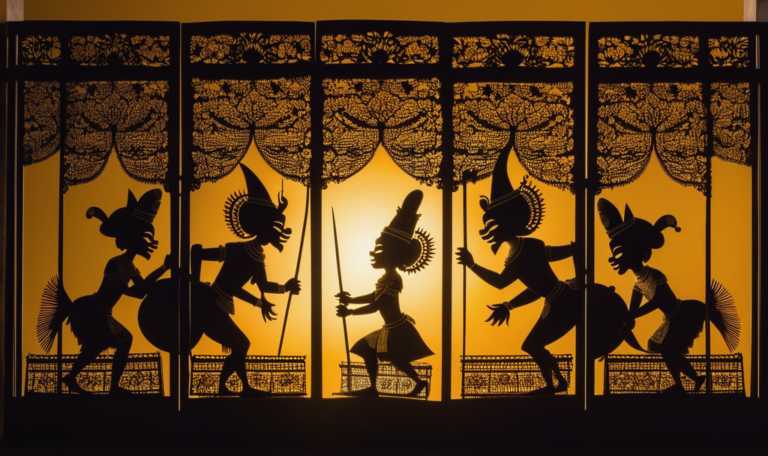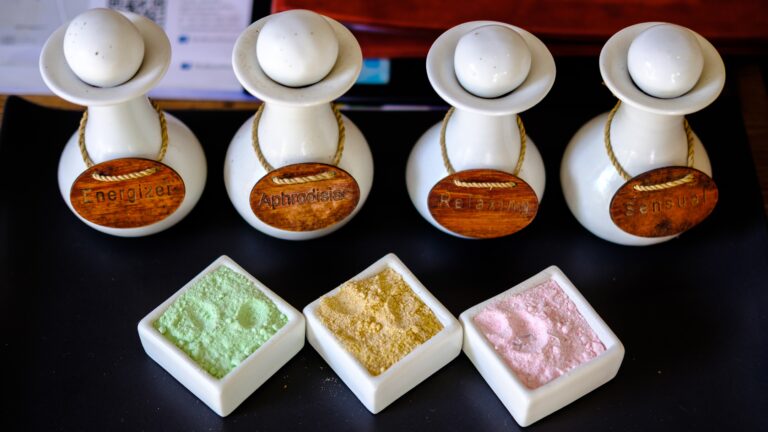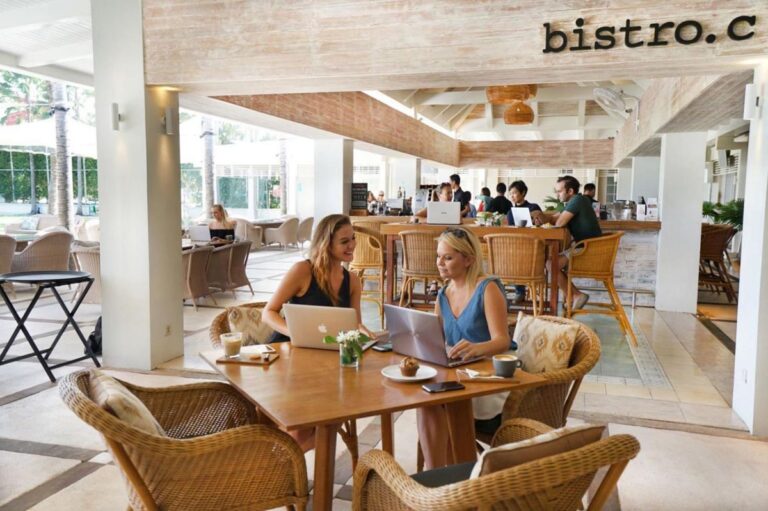Balinese offerings are everywhere you look on the island. Local Balinese communities use them as part of everyday life and not just in major religious ceremonies.
Our guide to these daily Balinese offerings will help you better understand the Balinese people and the Balinese Hinduism which underpins nearly every interaction here in Bali.
Offerings In Bali And The Balinese People
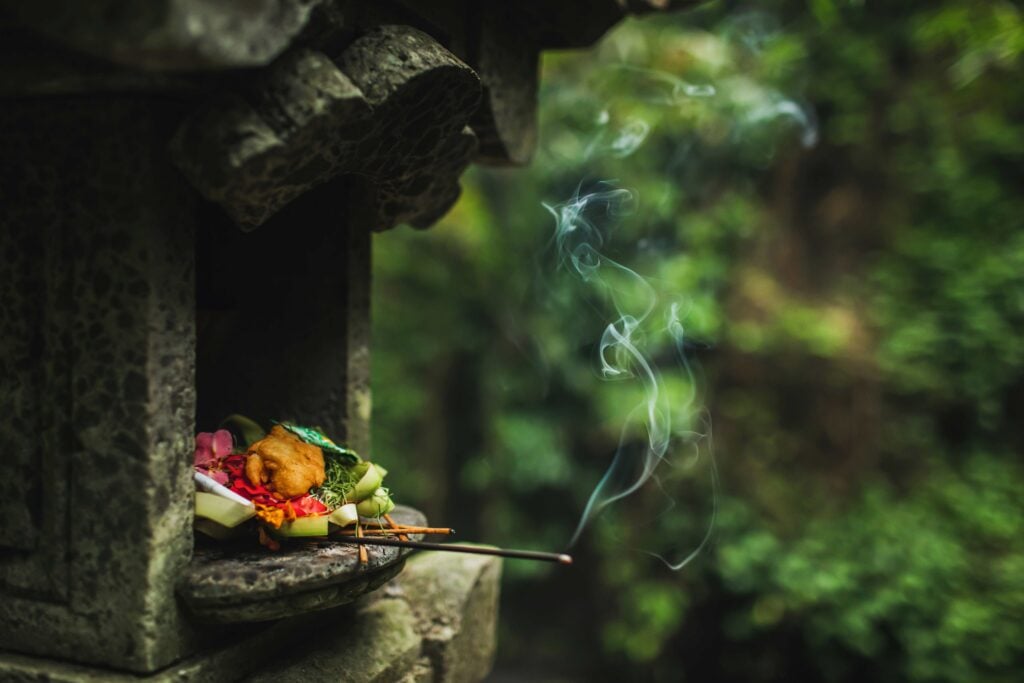
Firstly, it’s important to acknowledge why the people of Bali create Balinese offerings and you can find the answer to that in the Bhagavad Gita:
“Whosoever offers to me with devotion a leaf, a flower, a fruit, or water, that offering of love, of the pure heart I accept (ix:26)”
This is part of a conversation between Khrisna and Arjuna and it makes it very clear what is execpted as an offering.
While you can find Balinese women preparing a wide range of offerings on the island, each offering must contain each of the individual components that are mentioned in the verse.
The good news is that these components are all natural and can be easily found in daily life: colorful flowers, food, palm leaves, etc.
The Balinese provide offerings to help maintain balance between the Hindu Gods and the spiritual realm and the mortal realm of people.
Types Of Offerings (Banten)
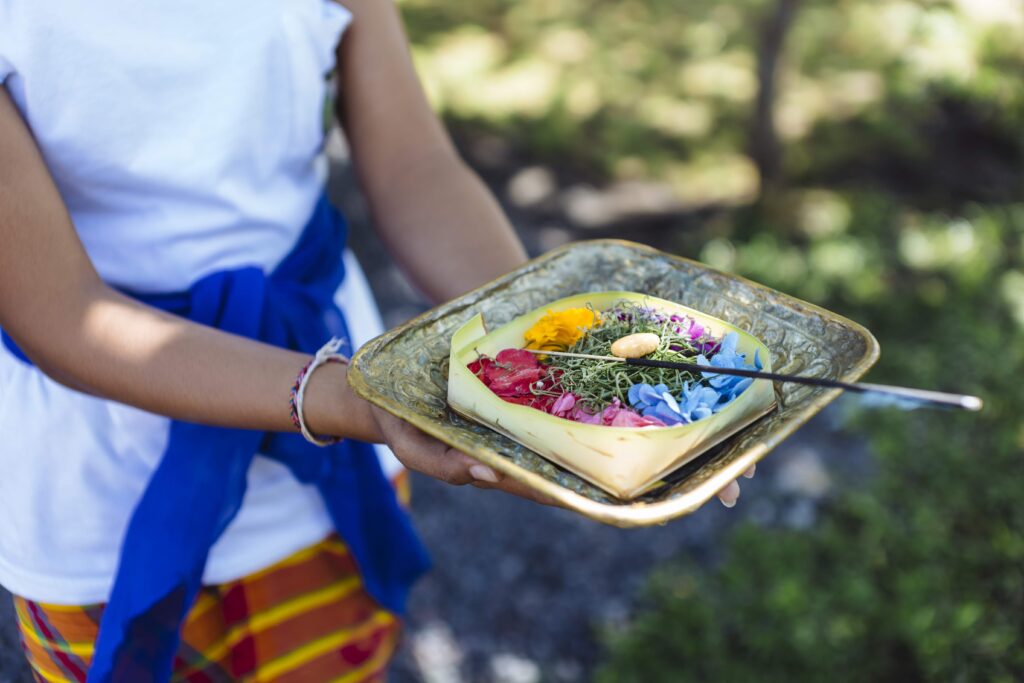
While many people believe because of its prevalance that the canang sari is the only offering in Bali, there are actually many different offerings and each has its own meaning.
Canang Sari/Canang
The canang sari is the, by far, the most common offering and you can often see it on the floor outside of houses and businesses during the day.
The burning incense carries the essence of the offering to the gods themselves and it’s very bad form to step over a canang sari while the incense sticks are still burning.
You should never step on a canang sari, so please keep your eyes p eeled for them and look down before you step forward.
Canang sari, typically, are used for a single day and are then replaced the next day with a new canang sari.
Gebogan/Banten Tegeh
At the other end of the scale from canang sari, you will find the most impressive offerings the Banten Tegeh.
Balinese women carry a large stack of either fruit or food on their hands and must maintain balance as they walk to their local temple.
These offerings come from traditional markets and presented during the “odalan” which is a village temple celebration which occurs one a year in the Balinese calendar.
They are made on a stable base of wood with a spike running down the centre and bamboo skewers are used to secure the food.
There is also a canang sari placed right on top of the offering.
Lamak
A lamak is a placemat that is used to place offerings of natural materials and other products on Galungan Day.
You can see them when you’re visiting temples, they appear to be a mat of colored, dried leaves. Woven palm leaves (coconut leaves) and banana leaves are the most common leaves used for these purposes.
Sampian
These very small offerings sit inside the small tray of the canang sari and they are sort of “practice offerings”.
Young girls learn to make a sampian for their family shrines and canang sari before they are taught more complex designs.
Daksina
These are small baskets made of palm leaves that include a bag of rice, a single duck egg, some coconuts, sacred tools as well as a canang sari.
They create a symbolic fusion of the most important staples in Balinese life for the Hindu Gods and are used mainly on big festival days.
Madya Or Utama
This offering is typically only made by high caste women who have been specially trained in its creation.
The madya or utama is a colorful cake made from a rice dough and then shaped into a semblance of a plant, animal or even person.
The rice cakes can take up to several weeks to prepare and can be up to 5 meters tall!
They are said to symbolize the harmonious relationship of all the elements of the universe from the underworld, through the greater world, to the heavens.
Balinese Women & The Art Of The Offering
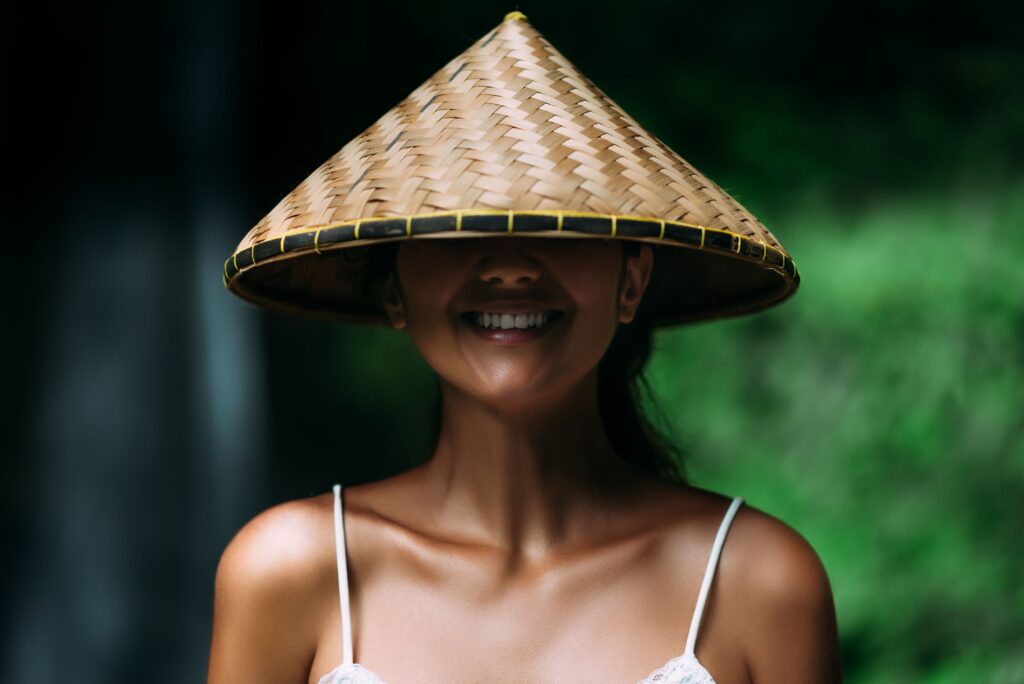
It is Balinese women who are responsible for the creation of offerings in Balinese society and the preparation of offerings is considered an absolutely essential skill.
The skill is called “mejejaitan” and without it, a woman would find it difficult to find her place in society.
Offerings are expected to be as beautiful as possible because that beauty is meant to delight the gods themselves.
If an offering isn’t beautiful enough, it’s possible that the gods would reject it and thus, the wishes that the creator had for themselves.
Interestingly, because the local form of Hinduism stresses the importance of balance – the Balinese don’t just make offerings to “good gods” but they also make them for the gods of negative forces too.
This is because they want to please good forces to work for them and to appease negative ones to ensure that they don’t work against them.
However, Bethara Bethari (offerings to the good forces) are always placed on a higher platform while Butha Kala (those meant to keep evil at bay) are always placed on the ground!
The Self-Sacrifice

The act of making an offering is seen as an act of self-sacrifice. The person who crafts an offering is giving up their time (and money) to creat the offering.
Thus, they are directly investing part of themselves in the process. They make this sacrifice because it allows them to display their gratitude for their good fortune to the gods and the universe itself.
Not all Balinese can articulate the reasoning behind the offering process because it’s so deeply ingrained in their culture but they all share this motivation.
They sincerely believe that the gods take real pleasure in the offerings that they leave for them.
Etiquette And Balinese Offerings
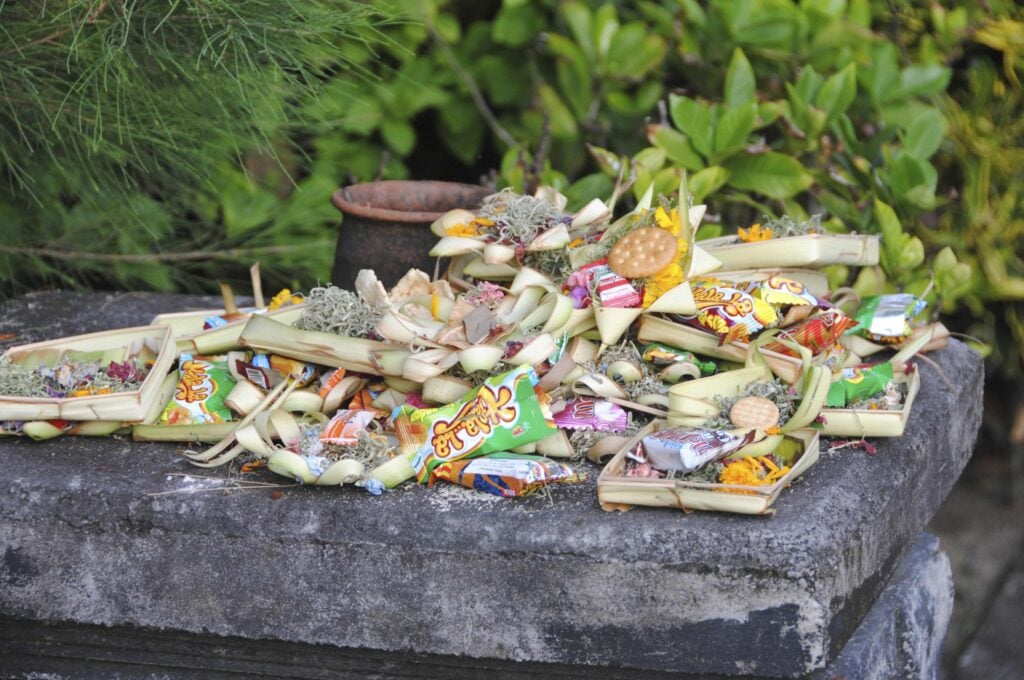
With offerings so deeply rooted in the local culture it’s a good idea to be aware of the etiquette around them before you accidentally cause somebody a deep sense of upset:
-
Keep in mind that these beautiful offerings are life lessons for the individuals who make them and that they are paying tribue to the major Hindu gods. That’s not something to take lightly in any culture.
-
Don’t touch, move or otherwise disturb an offering. Step around them if you see them and treat them with respect.
-
Don’t take photos of the offerings. To you these might seem like a bunch of young coconut leaves with some betel nut and rice wine but this daily ritual of Balinese life has deep meaning and it’s best not to disturb any offering without express permission of its creator.
-
Don’t try and create your own offerings. This won’t create more joy and in stark contrast, it can cause local people to feel very hurt, the offerings have different meanings but they are all religiously significant and thus, an outsider making an offering can feel like mockery.
FAQs
What Are The Offerings In Front Of Shops In Bali?
The Balinese offerings found in front of shops in Bali are usually canang sari, the small ever day offerings that are made to think Sang Hyang Widhi Wasa for the good things in life.
They are also seen in temples (pura), household shrines and on the grounds of businesses, government offices, etc.
They are considered sacred and used to express gratitude to the various Gods that impact on the daily lives of the people in Bali.
These offerings are daily offerings and each daily offering is replaced with a new offering after a day has elapsed.
What Are The Buddhist Offerings In Bali?
Balinese offerings are Hindu in nature as opposed to Buddhist.
While Balinese Hinduism holds deep respect for Buddhist saints (the Boddhisatva) there are very few actual Buddhists in Bali or, indeed, in Indonesia.
In total, there are about 0.7% Buddhists throughout all the islands of the archipelago.
If you do encounter Buddhists, they do not use canang sari, but many of their other offerings are similar to those used by Hindus.
What Are The Offering Baskets In Bali?
The small offering baskets in Bali are known as canang sari.
What Are The Flower Offerings In Bali?
There are four types of flowers used in offerings here in Bali and they are colour coded, one for each major Hindu God:
-
White flowers are for Iswara (one of the primary forms of the supreme God) they should point to the East
-
Red flowers are for Brahma (the father of all human beings) and they should point to the South
-
Yellow flowers are for Mahadeva (this is the “great god” of Hinduism) and should point West
-
Blue (or sometimes, green) flowers are for Vishnu (“the preserver” and a key figure of the Hindu Trimurty or Hindu Trinity) and should point North.
In addition, a jepun flower (frangipani) is dipped in holy water and then the water is sprinkled over the daily offerings to help “fuse” the four elements of these important offerings.
Interestingly, you can also find another set of common ingredients in the offerings of Bali: Betel Leaves, Lime and Areca Nuts.
These are ingredients which are meant to reflect the Hindu Trinity and the red of the Areca symbolizes Brahma, the green of the Betel leaf is to symbolize Wisnu and the white of the lime is for Siwa.
Thus, when you see them, they are providing for each of the most important gods within the offering.
What Is The Balinese Offering To The Gods?
There are many different Balinese offerings but the most commmon of them is canang sari.
What Is The Sacred Ritual In Bali?
Perhaps, the best known Balinese ritual is the Melukat. This is a purification ritual which is conducted at places of holy water (water temples) and the idea is to cleanse someone’s mind, body and spirit of any negative forces or evil spirits.
How To Book A Holiday To Bali To See Balinese Offerings
If you’re interested in coming to Bali to learn more about Balinese Culture and Balinese offerings such as the canang sari, we recommend talking to the lovely people at the Bali Res Centre.
The Bali Res Centre is locally owned, managed and operated and focuses on Balinese travel experiences.
They can ensure you get a competitive deal on accommodations and transport and see all the things you want to see on the island.
The best thing about dealing with the Bali Res Centre is that it ensures your money stays in the Balinese economy and doesn’t end up overseas in the pockets of a multinational.
Final Thoughts On Balinese Offerings
The Balinese people give offerings to show their gratitude to the gods for the things that they have and in hopes of future kindness from the very same gods.
Balinese offerings can thus be found throughout Balinese society and not just at sacred sites throughout the land.
The most common offerings are called canang sari but you can find many others if you look closely.
Understanding these offerings helps you to better understand Balinese culture and the Balinese Hinduism that impacts every aspect of life on the island.
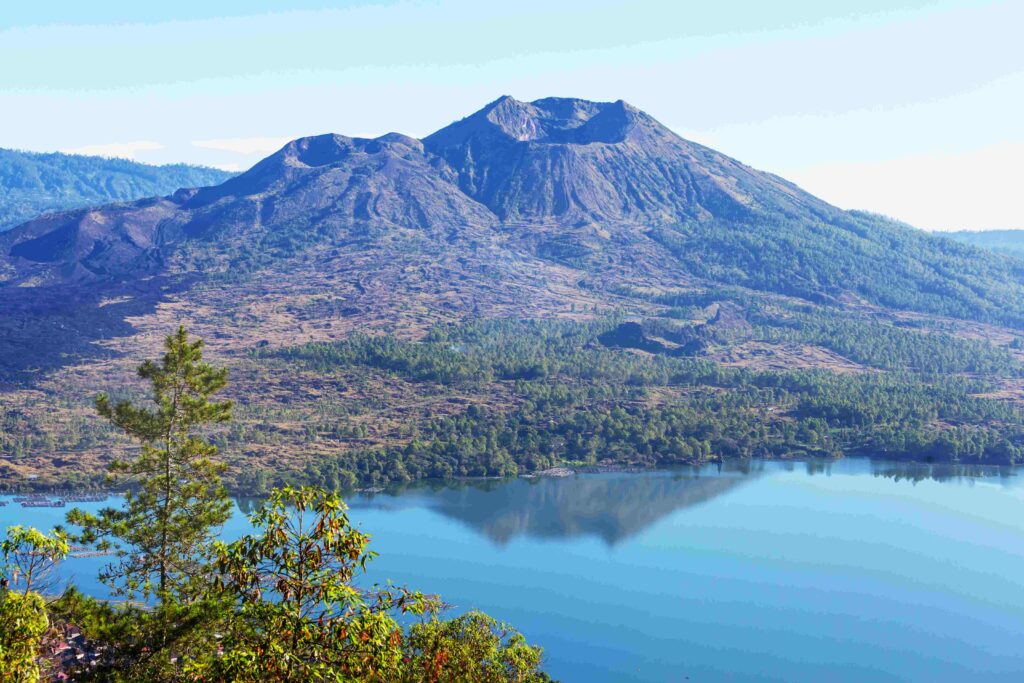
Hike To Danau Batur – the white crater lake is amazing at any time of the year and it’s easy to get to on foot. This is a hidden gem and still off-the-beaten-path for many tourists which means you can get some amazing shots of the blue sapphire waters of the lake and some blissful solitude at the same time.

Splash Water Park – there’s nothing finer than cooling off and having fun after a day in the Bali sun. Splash is the best place for it.
What Are The Best Things To Do In Bali During April?
There are a few festivals that take place in April here in Bali too and you might want to check out:
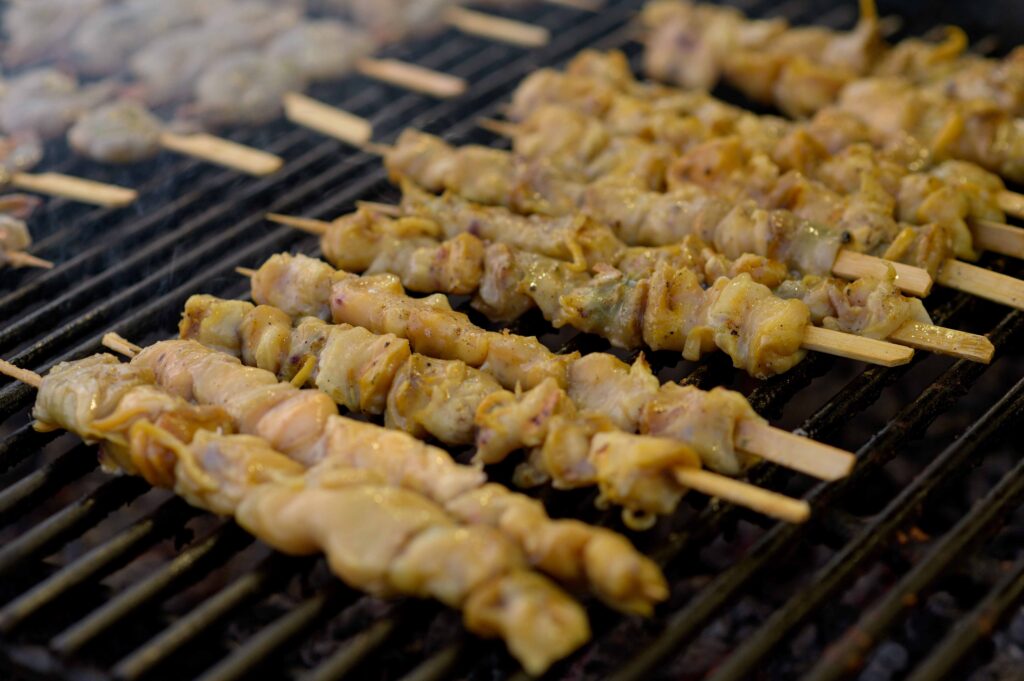
-
Ubud Food Festival – this actually takes place in April, May or June but they sometimes hold some warm-up publicity-style events to promote the main festival in April and May even if the festival is later in the year, so keep your eyes peeled when visiting Ubud.
-
Tumpek Krulut – this is the fourth day in the Tumpek Cycle and is a major festival with gamelan instruments and traditional dancing at many temples.
-
Kartini Day – this is a national holiday in Indonesia that celebrates the birth of Ajeng Kartini, she is a national hero who campaigned tirelessly for women’s rights and education.
-
Lovina Beach Festival – if the dolphins weren’t a good reason to head to this beach resort, then maybe a festival will be? This is a wonderful showcase of the best of Balinese culture which includes bull racing, puppet shows, live music, floral offerings, handicraft exhibitions and photography contests!
What Should I Bring To Bali In April?
You don’t need to bring anything special to Bali for April. Pack light but ensure you have a lightweight jacket in case it rains, go with breathable clothing because it’s still a little humid and don’t forget the sunscreen.
FAQs
Is April A Good Time To Go To Bali?
There are no bad times to go to Bali. April is, in fact, the borderline between the wet and dry seasons in Bali. That means it will rain a little more than usual, but not so much that it’s unbearable.
It will also be slightly hotter and more humid than it can be in the following six months. However, there are some advantages to coming to Bali at this time of year too.
It’s less busy and that means you can visit the tourist sites without overcrowding affecting your enjoyment of things and you will find that flights and accomodation tend to be a bit cheaper.
We’ve found that spas, retail outlets and even restaurants can offer exciting promotions at this time of year to attract business when there are fewer people around.
There is also a 25% chance that any given day in April will be sunny without a cloud in the sky!
Is Bali Rainy In April? Does It Rain A Lot In Bali In April?
It’s the last month of the rainy season and that means that while it does rain in April, the amount of rain is much lower than in the previous 4 months or so.
It only rains for 12-14 days out of the 30 days of April and that tends to come in short bursts rather than long showers. Almost every day a this time of year will have long periods of sunshine.
Is It Better To Go To Bali In April or May?
It depends, if you’re thinking of coming to Bali during the Australia April School Holidays, you’re going to find it’s very busy and if that also overlaps with Easter (which can be in April or March) it will be busier still.
However, outside of these dates, there’s not a huge amount in it. You will get better deals on accomodation and flights in the quieter part of April but you will get slightly better weather in May.
Apart from the school holiday period, both months are not as busy as Bali can get and you will find there’s plenty of room on the beaches and at tourist attractions around the island.
If you do come during the school holidays, we’d recommend that you book a long way in advance if you have a specific place that you want to stay. You should also consider booking any activities you want to do in advance.
Which Month Is Coldest In Bali?
January is the coldest month in Bali with an average daily maximum of around 26 degrees (82 degrees Fahrenheit), May is the hottest month with an average temperature of 28 degrees Celsius (82 degrees Fahrenheit).
April is somewhere between the two but it has the most daily hours of sunshine – 9 hours a day.
What Is The UV in Bali In April?
The average UV rating on Bali’s beaches in April is 13.4. This is a very strong level of ultraviolet light and it is strongly recommended that you use a high SPF factor sunscreen if you visit the island at this time of year.
Unprotected skin can begin to burn in less than 10 minutes in this kind of UV. It’s not enough to put sunscreen on once, you need to reapply it every 2 hours or so, even when it’s cloudy outside.
If you want to tan, it’s best to hit the beaches before 10 a.m. or after 4 p.m. but even at those times, you should be using sun cream.
You should also know that reflections from water can increase the intensity of your UV exposure. UV levels are a guideline, not a guarantee.
What Season Is It In Bali In April?
It’s the end of the wet season in Bali in April. Bali rarely has bad weather in any season and by mid-April it’s starting to feel like the dry season with mainly sunny days and much more than a few hours of sun each day – 9 hours, on average, to be precise.
That means it’s good beach weather and a great time to learn water sports and to snorkel around a coral reef or two. It’s not high season though, so you can expect competitive prices for most things.
What’s The Average Weather Like In Bali In March/April?
There’s some rain in Bali during April and March but mainly it’s hot, sunny and humid and the weather in Bali is always warm and tropical all year round.
With maximum temperatures of around 30-31 degrees Celsius (88-89 degrees Fahrenheit) and minimum temperatures of 22-25 degrees Celsius (72-73 degrees Fahrenheit) and 9 hours of sunshine each day, the weather in Bali at this time of year isn’t a reason not to visit.
Is April Part Of The Rainy Season/Wet Season In Bali?
Yes, but it’s the end of the season and the weather in April in Bali tends to be warm and pleasant and rains are nowhere near as heavy as they can be at other times of the year.
How Should I Book An April Holiday In Bali?
We recommend that you book your holiday in Bali through the Bali Res Centre which is a locally owned and managed travel agent that really understands what people are looking for from a Bali holiday.
They can arrange flights, accommodation and any tours that you need and ensure that you get the best deals for you, your friends and your family.
Best of all, when you book through the Bali Res Centre, you’re keeping your holiday money in Bali and not sending it overseas to a multinational corporation.
Final Thoughts On Bali Weather, April
The weather in Bali in April is really pleasant and it’s the sunniest month of the year! You can swim, hike, go snorkeling, and much more!
If you do decide to visit Bali in April, we hope to see you at FINNS the best beach club in the world, as all visitors to the island know, we’ve got great food, awesome drinks and fabulous entertainment, all year long!






